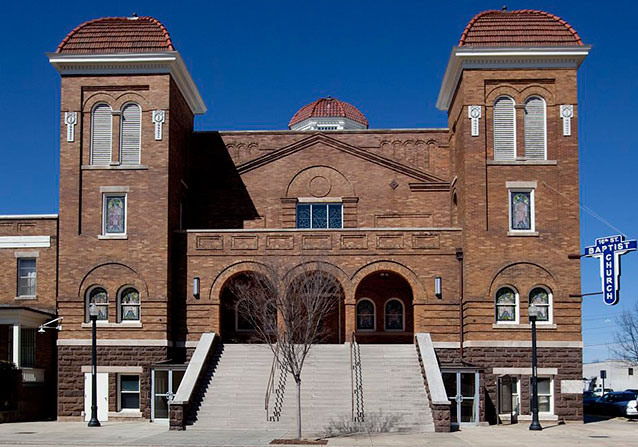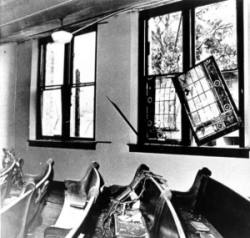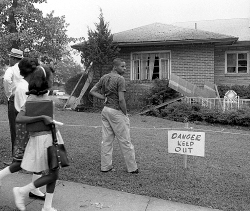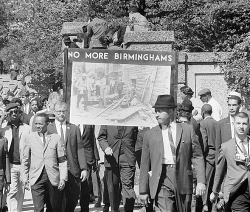Blue Bloods Quote You Have a Right to Be Safe Streets Playgrounds
16th Street Baptist Church Bombing (1963)

Carol Highsmith Photo
On September 15, 1963, the congregation of the 16th Street Baptist Church in Birmingham, Alabama greeted each other before the start of Sunday service. In the basement of the church, five young girls, two of them sisters, gathered in the ladies room in their best dresses, happily chatting about the first days of the new school year. It was Youth Day and excitement filled the air, they were going to take part in the Sunday adult service.
Just before 11 o'clock, instead of rising to begin prayers the congregation was knocked to the ground. As a bomb exploded under the steps of the church, they sought safety under the pews and shielded each other from falling debris. In the basement, four little girls, 14-year-olds Addie Mae Collins, Denise McNair, Carole Robertson, and 11-year-old Cynthia Wesley, were killed. Addie's sister Sarah survived, but lost her right eye.
In the moments after the explosion, questions hung in the air - 'Where is my loved one?' 'Are they ok?' 'How much longer can this violence last?' They did not ask if this was an accident, they knew that this was a bomb that had exploded as it had dozens of times before in "Bombingham."
The Aftermath

Birmingham Public Library
Upon learning of the bombing at the Church, Reverend Martin Luther King, Jr. sent a telegram to Alabama Governor George Wallace, a staunch and vocal segregationist, stating bluntly: 'The blood of our little children is on your hands." The brutal attack and the deaths of the four little girls shocked the nation and drew international attention to the violent struggle for civil rights in Birmingham. Many whites were as outraged by the incident as blacks and offered services and condolences to the families. Over, 8,000 people attended the girls' funeral service at Reverend John Porter's Sixth Avenue Baptist Church.
The deaths of the four girls was followed two months later by the assassination of President John F. Kennedy, causing an outpouring of national grief, galvanizing the civil rights movement and ensuring the passage of the 1964 Civil Rights Act.
Why This Church?
16th Street Baptist was a large and prominent church located downtown, just blocks from Birmingham's commercial district and City Hall. Since its construction in 1911, the church had served as the centerpiece of the city's African American community, functioning as a meeting place, social center, and lecture hall. Because of its size, location, and importance to the community, the church served as headquarters for civil rights mass meetings and rallies in the early 1960s.
Birmingham was the most segregated city in the United States and in April 1963, after an invitation by Reverend Fred Shuttlesworth to come help desegregate Birmingham, the city became the focus of Martin Luther King, Jr. and the Southern Christian Leadership Conference (SCLC). The desegregation campaign conceived by Shuttleworth was known as "Project C" and was to be a series of nonviolent protests and boycotts.
Despite resistance from some of the church's leadership and members of the congregation, the 16th Street Baptist Church joined the SCLC in their campaign. The church became the departure point for many of the demonstrations that took place in the city. On May 2, 1963, students ranging in age from eight to eighteen gathered at the church to march downtown and talk to the new mayor about segregation. After leaving the church they were met by police and many were jailed. By the time the "Children's Crusade" and the ensuing demonstrations ended on May 10th, thousands of children and adults had been injured by fire hoses and attack dogs and incarcerated by order of "Bull" Connor, Commissioner of Public Safety.
The church came to be viewed by many as a symbol and a rallying place for civil rights activists; and it became the focal point for racial tensions and white hostility towards the civil rights movement in Birmingham.
Why Now?

Marion S. Trikosko, LOC, LC-U9- 10409-18A
Due to the success of the Birmingham Campaign, on May 10, 1963, the city agreed to desegregate lunch counters, restrooms, drinking fountains, and fitting rooms, to hire African Americans in stores as salesmen and clerks, and to release the jailed demonstrators. White segregationists opposed desegregation, however, and violence continued to plague the city.
On May 11th, a bomb destroyed the Gaston Motel where Martin Luther King, Jr. had been staying and another damaged the house of King's brother, A. D. King. NAACP attorney Arthur Shores' house was fire bombed on August 20th and September 4th in retaliation for his attempts to help integrate the Birmingham public schools. On September 9th, President John F. Kennedy took control of the Alabama National Guard, which Governor Wallace was using to block court-ordered desegregation of public schools in Birmingham. Around that time Robert Chambliss, who would later be named as a suspect in the 16th Street Baptist Church bombing, foreshadowed the violence to come when he told his niece, "Just wait until Sunday morning and they'll beg us to let them segregate."
Eventual Justice

Thomas J. O'Halloran, LOC, LC-U9- 10515-6A
The FBI office in Birmingham launched an immediate investigation. In a 1965 memo to J. Edgar Hoover, FBI agents named four men as primary suspects for the bombing - Thomas Blanton, Robert Chambliss, Bobby Frank Cherry, and Herman Cash. All four men were members of Birmingham's Cahaba River Group, a splinter group of the Eastview Klavern #13 chapter of the Ku Klux Klan. Eastview Klavern #13 was considered one of the most violent groups in the South and was responsible for the 1961 attacks on the Freedom Riders at the Trailways bus station in Birmingham.
The investigation ended in 1968 with no indictments. According to the FBI, although they had identified the four suspects, witnesses were reluctant to talk and physical evidence was lacking. In addition, information from FBI surveillances was not admissible in court. Hoover chose not to approve arrests, stating, "The chance of prosecution in state or federal court is remote." Although Chambliss was convicted on an explosives charge, no charges were filed in the 1960s for the bombing of the church.
In 1971, Alabama Attorney General Bill Baxley reopened the case, requesting evidence from the FBI and building trust with witnesses who had been reluctant to testify. Investigators discovered that, while the FBI had accumulated evidence against the bombers, under orders from Hoover they had not disclosed the evidence to county prosecutors. Robert Chambliss was convicted of murder on November 14, 1977; however, it would be decades before the other suspects were tried for their crimes. In 2000, the FBI assisted Alabama state authorities in bringing charges against the remaining suspects. On May 1, 2001, Thomas Blanton was convicted and sentenced to life in prison. In 2002, Bobby Frank Cherry was convicted as well. His boasts that he was the one who planted the bomb next to the church wall helped send Cherry to prison for life. Herman Cash died in 1994 having never been prosecuted for the murders of the four girls.
A project through the African American Civil Rights Grant Program, which works to document, interpret, and preserve the sites and stories related to the African American struggle to gain equal rights, is funding ongoing rehabilitation work at the 16th Street Baptist Church.
Source: https://www.nps.gov/articles/16thstreetbaptist.htm
0 Response to "Blue Bloods Quote You Have a Right to Be Safe Streets Playgrounds"
Post a Comment